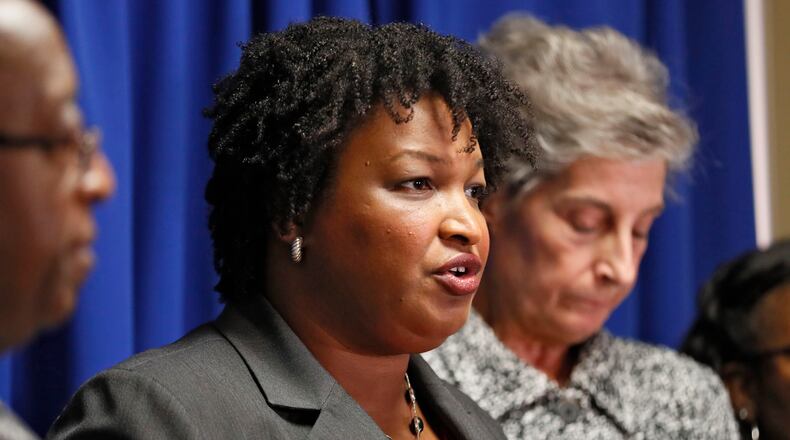The fact that Stacey Abrams was on the line Tuesday afternoon, taking time out of her Democratic campaign for governor, was an indication of the topic's volatility.
But this is a complicated tale, as most important ones are. So bear with me.
Last week, The Intercept, a news website backed by EBay founder Pierre Omidyar, delved into a federal lawsuit charging that, in 2015, our Republican-controlled state Legislature engaged in the racial gerrymandering of several state House districts.
House Bill 566 won the unanimous approval of the House. Only in the Senate did Democrats rouse themselves in opposition, but the measure still passed, 39-14.
Two legal challenges filed last year, by the NAACP and a group led by former U.S. attorney general Eric Holder, have been merged into one. No trial date has been set, but some sworn testimony has been transcribed.
Last week, The Intercept noted that, in defense of their actions and as proof that no racial motive existed, several GOP lawmakers stated outright or implied that Abrams, then leader of the House Democratic caucus, had green-lighted the bill.
Though he’s now a state senator, Brian Strickland, R-McDonough, as a member of the House benefited from HB 566. He said Abrams “had signed off” on the changes.
Randy Nix, chairman of the House Reapportionment Committee, testified that he had talked with Abrams about the content of the bill and had received her support.
State Rep. Chuck Efstration, R-Dacula, reported that he sat in the same row with Abrams in the House chamber that year, and that “there had been no partisan objection whatsoever to the legislation at the time.”
You can see the problem.
Abrams, the frontrunner on the Democratic side of the race for governor, has embarked on an untested strategy that rests — in large part — on an effort to seek out and register voters who are often ignored during elections. In other words, African-Americans and other minorities.
It makes no difference that then-state Rep. Stacey Evans, D-Smyrna, who is now her rival in the Democratic race for governor, also voted for the bill. We haven’t heard from Evans on this topic, but several other House Democrats said they were simply following Abrams’ lead.
Thus, we have only two possible scenarios: If her Republican colleagues are to be believed, Abrams was complicit in reducing the political clout of minority voters touched by HB 566. Or she was duped.
Neither is a good look for a gubernatorial candidate, but the lawsuit suggests the latter: “[M]inority and Democratic legislators in the House of Representatives were initially given no indication that the changes contained the bill were anything other than innocuous and minor.”
And in our phone interview, Abrams said she and other Democrats supported the bill “based on the word of someone with whom I worked very closely, Chairman Nix.” In the end, she said, she was betrayed.
First, a word on legislation that determines political boundaries in Georgia and elsewhere. If you're reading this online, click on this link to HB 566. If not, then you'll have to take my word for it: The bill's content is nothing but an indecipherable series of coordinates and precinct names.
There are two ways to figure out what a redistricting bill does: Hire a consultant with a computer and the right software, or take the word of the bill’s author. After the 2010 census, when all political boundaries in the state were subject to change, Democrats hired a professional to look things over.
They didn’t like what they saw, and Abrams, newly elected as the leader of the caucus, threatened to field primary challengers against any fellow Democrat who voted for the maps.
Five years later, because the scope of this redistricting effort was much smaller, Abrams said she banked on Nix’ word.
Abrams said Tuesday that the chairman of the House Reapportionment Committee had assured her that the primary purpose of HB 566 was to make small adjustments in the House district of Speaker pro tem Jan Jones, R-Milton, which abutted only other Republican districts. And to accommodate a swap of Atlanta voters between state Reps. Margaret Kaiser and Keisha Waites, both Democrats — which gave the bill a bipartisan cast.
“Several seats were added afterwards,” Abrams said. A total of 17 House districts were affected, but the lawsuit focuses on two House seats, District 105 in Gwinnett County, then held by Joyce Chandler, a white Republican, and District 111 in Henry County, held by Brian Strickland, also a white Republican.
Demographically, both Gwinnett and Henry counties are rapidly changing, in favor of Democrats. HB 566 sent more white voters into each of the two House districts. (In legal arguments, the state argues that map drawers didn’t rely on racial statistics — only on whether the shifted voters were more likely to vote Republican or Democratic. In a racially polarized South, that can be one and the same thing — but we’ll let a judge sort that one out.)
Some House Democrats have suggested that caucus support for the bill was ordered up by Abrams. She denies that, but admitted that her fellow Democrats thought they were voting to help two Democratic colleagues, Kaiser and Waites.
Only after the unanimous vote in favor of HB 566, Abrams said, did she learn of the additional content. “I expressed my deep discontent” with Nix, the chairman of the House line-drawing committee. It was a verbal exchange rather than written, she said.
We’ve put a call into Nix, but have not heard back.
Credit: David Barnes
Credit: David Barnes
Upon learning she had been misled, Abrams said she immediately went to Senate Democrats to ask them to try and block the bill. The effort, led by state Sen. Vincent Fort, D-Atlanta, failed.
Fort, who is now an Evans’ supporter, said this week that he suspected Abrams of complicity with Republicans in pushing the bill, but could offer no proof.
Abrams also said that, after the incident, she rallied national Democrats to the gerrymandering issue in Georgia. Her campaign provided a statement from Jessica Post, executive director of the Democratic Legislative Campaign Committee, which reads in part: “When Stacey Abrams realized what the GOP had snuck into the bill, …[s]he reached out to the DLCC to enlist national help. At the time, we didn’t have the resources needed to take on the challenge during a presidential election year.”
However, in 2017, Post said her group connected Abrams with Holder, the former U.S. attorney. A branch of his group, the National Democratic Redistricting Committee, is a party to the current Georgia gerrymandering suit.
On Tuesday, Abrams took credit for that.
About the Author
The Latest
Featured





